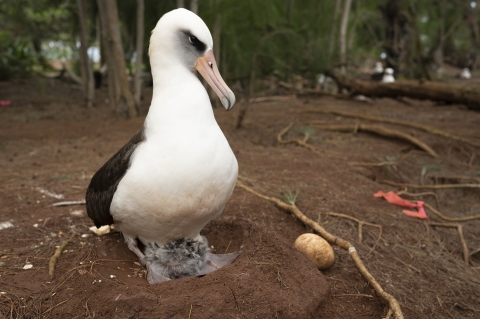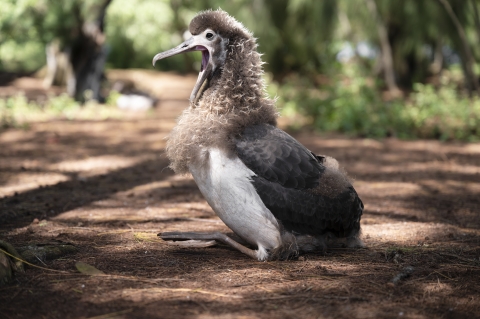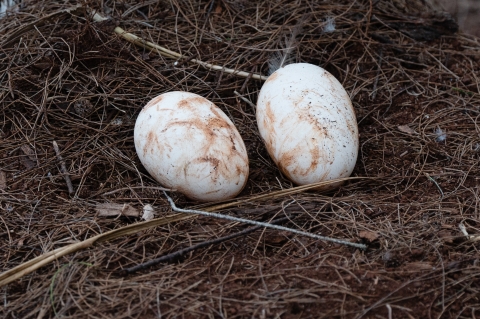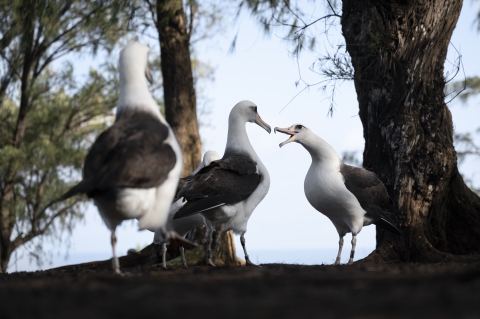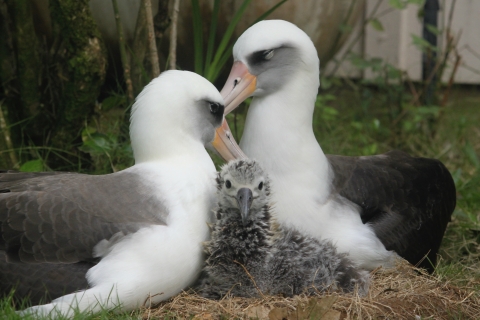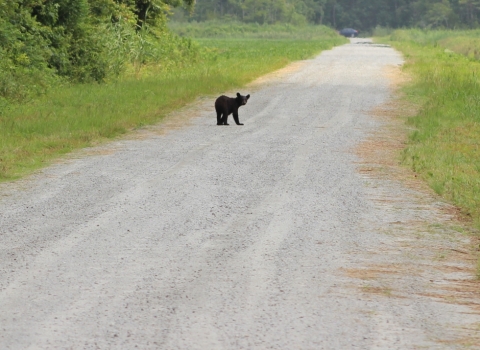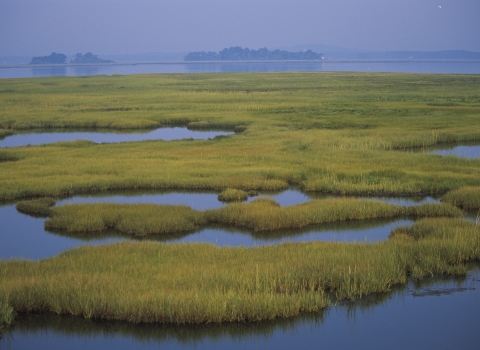In celebration of Pride Month, we are spotlighting Laysan albatross (or mōlī in ōlelo Hawai‘i)— one of many animal species that displays same-sex breeding behaviors including courting, intimacy, co-parenting, and forming decades long monogamous partnerships.
In a population with fewer males than females, same-sex pairing among female mōlī has been observed for decades in Hawai‘i and has proved to be an adaptive reproductive strategy. Every breeding season, female birds in same-sex partnerships successfully nest, incubate eggs, and raise their chick together.
Why Some Mōlī Have Two Mothers
Laysan albatross colonies within the main Hawaiian Islands typically have a skewed sex-ratio with more female albatross than males. This is because Laysan albatross have female biased immigration. In other words, females are more likely than males to immigrate from outer islands to new colonies on the main Hawaiian Islands.
With an abundance of females, male mōlī are selective when forming pair bonds. Female birds that are rejected by males or prefer a female partner will partner with one another and rely on a chance opportunity to copulate with a male and have their egg fertilized.
Both females can lay a single egg each year, but only one will ultimately be incubated. Mōlī, like all seabirds, can only raise one chick each nesting season. The physically demanding 60 days of egg incubation followed by 165 days of chick rearing is physically demanding and raising just a single chick to fledge requires two dedicated parents.
Parenting duties do not differ between the sexes with one exception; the female lays the egg, and the male takes the first incubation shift while she goes out to sea to feed and recover lost nutrients. In female-female pairs, while the pair will only incubate one egg, both birds may lay an egg. The female bird that takes the first incubation shift does not get time to recover before the approximately three weeks long fast required while she awaits her partner's return. During this time, she is more likely to abandon her egg than a male bird taking the first incubation shift. However, research suggests that if an egg hatches, female-female couples are just as successful at getting their chick to fledge as their male-female counterparts.
Most of what we know about female-female albatross pairings is from a 2008 study at Ka‘ena Point Natural Area Reserve on O‘ahu. Dr. Lindsay Young and Dr. Eric VanderWerf collected data on breeding cycles over the course of four years as part of their doctoral research at the University of Hawai‘i.
Of the mōlī included in the study, male-female pairs were about twice as successful at hatching and raising their chick to fledge as their female-female counterparts, (they had a 59% success rate versus 31%). Even with this disparity, female-female pairing has proven successful as the alternative of not pairing, would produce no offspring at all.
There is Still More to Learn
Volunteers all over Hawai‘i, including on Kaua‘i, continue to collect weekly data on Laysan albatross throughout their nesting seasons. Dr. Young hopes to use this data and conduct further research on the long-term success of chicks raised by two female parents.
Dr. Young has also observed another adaptive breeding strategy— Laysan albatross forming “throuples,” with two female birds raising a chick with one male. “They've got three parents feeding them,” said Dr. Young in a May interview with USFWS, “and those chicks are fat.”
Making Parenthood Possible
Laysan albatross started to expand their range across the Pacific in the late 1960s, going beyond their typical Northwestern Pacific Island demographic. With more birds in new airspace, bird-air strike collisions near U.S. Pacific Missile Range Facility (PMRF) became increasingly problematic.
In 1988, adult birds were deterred away from the PRMF and their eggs were legally destroyed to discourage them from establishing a permanent colony. This was part of the BASH or Bird-Air Strike Hazard reduction program to protect this population of Laysan albatross, a near-threatened species. The program was unsuccessful. Mōlī are typically as loyal to their nesting grounds as they are to their mate and continued to nest at PMRF.
In 2005, the U.S. Navy, U.S. Fish and Wildlife Service, and U.S. Department of Agriculture partnered to initiate an “albatross egg swap” program where fertilized eggs laid by Laysan albatross on the PMRF were replaced with unfertilized eggs from pairs at the Kīlauea Point National Wildlife Refuge (KPNWR) and at nearby private properties. Shortly after the program was founded, the non-profit Pacific Rim Conservation joined the cause and undertook most of the egg relocation and egg incubation associated with the translocation projects.
Most of the fertilized eggs from PMRF were given to female-female pairs who are naturally less likely to have their own fertilized egg. This egg swap program not only gave these mōlī mothers a chance to foster chicks, but it also prevented the destruction of many fertilized eggs that outnumbered that of available male-female nests.
By 2012, the albatross egg swap program was scaled down in part due to legislation imposed by the U.S. Department of Agriculture that limited the placement of foster eggs on private properties that lacked adequate fencing to protect the mōlī against predation. Around this same time, USFWS on Kaua‘i was unable to accept foster eggs, leaving only a small fraction of properties eligible to accept PMRF eggs.
Still, fertilized Laysan albatross eggs from PMRF continued to be placed across the North Shore of Kaua‘i as well as the neighboring island of O‘ahu, mostly given to female-female albatross pairs nesting on approved private properties. And in 2022, translocation efforts at the Kīlauea Point National Wildlife Refuge were resumed with 14 eggs from the Missile Range placed under pairs with an unfertilized egg.
Click and Clack - A Success Story
Throughout the 2000s, a long-term female Laysan albatrosses pair named Click and Clack nested in a small residential community on Kauai’s North Shore. For over a decade the couple captured the hearts of their human neighbors who observed them courting, preening, and nuzzling. Throughout the 14-years that they were regularly monitored, they successfully raised four chicks to fledge.
Click and Clack’s partnership was cut short when Clack, identifiable by band #643, did not return from sea in 2019. Community members mourned the missing bird. “This neighborhood really cares about these [birds], and they watch over them,” said Cathy Granholm, Department of Natural Land Resources, Division of Forestry Division volunteer, who has been collecting data on the birds since 2005.
Click has since paired with another female mōlī. The small community of bird lovers that surrounds them continue to watch and wait in hopes of celebrating future success stories of female-female raised Laysan albatross chicks on Kaua‘i and across the Hawaiian Archipelago.



